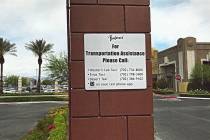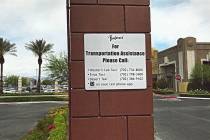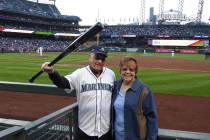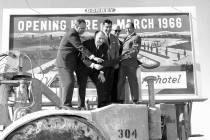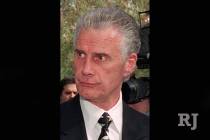Smith Center transcends the ADA to appeal to all the senses
My father jokes he knows every public family bathroom in Summerlin since my mother began using a wheelchair two years ago.
Without family bathrooms, he can't take her to certain places unless I am with them. He can't take her to the ladies room and use those stalls, nor can a woman escort a man into a men's room.
Family bathrooms give both sexes freedom to go in more ways than one. They're a deciding factor in where my parents go as a couple, where they eat, shop or see a show.
Discovering The Smith Center has seven family bathrooms thrilled the Morrisons.
Then we discovered wheelchair-accessible seating is available throughout Reynolds Hall. The Americans with Disabilities Act requires 16 wheelchair spaces for a hall this large. The Smith Center provides 32, and that doesn't count additional wheelchair-accessible seats in the boxes.
Plus, the center provided the technology for both hearing impaired, which is fairly commonplace, and visually impaired, which is less routine.
"We started with the ADA consultants from Day One making sure we over-delivered on ADA requirements," Myron Martin, president and CEO of The Smith Center, said.
The first time the visually impaired devices will be used is Sunday at the one-woman show in which Tovah Feldshuh portrays Golda Meir, the former prime minister of Israel, in "Golda's Balcony."
What happens on stage will be described through a device called D-Scriptive, which is inserted in the patron's ear.
Another device called the I-Caption provides individual captioning for the hearing impaired through a wireless hand-held device. Both are products of Sound Associates Inc.
Las Vegas attorney Bob Anderson serves on the advisory board for The Smith Center and also is board chairman for the Nevada Blind Children's Foundation despite not having a blind child himself. His interest in challenges facing the blind developed after he read a 1989 book called "If You Can See What I Hear" by Tom Sullivan.
During the planning period for The Smith Center, a staffer with the Blind Children's Foundation asked whether the performing arts center would provide devices for the hearing and visually impaired.
Anderson said he took it up with the center staff and provided information about the latest technology available.
"They got back to us within a week and said: 'We want to do this. We want to be the premier performing arts center in the country, if not the world.' The Smith Center has done everything we've asked of them," he said
Anderson volunteered to raise money to cover the $40,000 cost for the two devices, thinking it would make the blind community feel more connected to The Smith Center. The Blind Children's Foundation has a link for those wanting to donate, but he said that's independent from the foundation's other fundraising.
The drive quickly raised $10,400, and Anderson hopes to have the full reimbursement amount by the end of the year.
He was reluctant for me to print the rest of the story, but it's pertinent. Anderson has pledged to make up the difference himself if the full amount isn't raised from other sources.
There was no demand that the blind community pay the costs, Martin said, but Anderson volunteered when asked by Smith Center fundraiser Terry Jones.
Martin said the center did not ask the Blind Children's Foundation to raise any money. He said Anderson volunteered to underwrite the cost.
"Once again, the community was stepping forward to be a part of The Smith Center," Martin said
Jane Ann Morrison's column appears Monday, Thursday and Saturday. Email her at Jane@reviewjournal.com or call 702-383-0275. She also blogs at lvrj.com/blogs/morrison.









